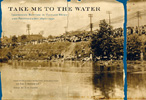 Take Me To The Water: Immersion Baptism in Vintage Music and Photography 1890-1950 is an astonishing document of 75 sepia photograph reproductions with a disc of 25 songs and sermons. As usual, the Dust to Digital label rises above concepts of social division and genre by including music made by both African-Americans and European-Americans. There's a primal appeal both to these sounds and to the haunting, almost other-worldly photographs.
Take Me To The Water: Immersion Baptism in Vintage Music and Photography 1890-1950 is an astonishing document of 75 sepia photograph reproductions with a disc of 25 songs and sermons. As usual, the Dust to Digital label rises above concepts of social division and genre by including music made by both African-Americans and European-Americans. There's a primal appeal both to these sounds and to the haunting, almost other-worldly photographs.
The value of water surely precedes our recorded history and the idea of water as an essential symbol of power and transformation resonates through the ages. From Biblical tales of God using a flood to cleanse sin, to the films Oh Brother Where Art Thou (where the protagonists are saved from lynching by the damming of a valley to provide hydro-electric power) and Trouble the Water (the unbelievable documentary of the storm which tried in vain to wash away New Orleans). Water dominates our planet and our bodies. The flow from spring and stream to river and into sea is a commonly accepted metaphor for growth, death and natural paths through life. We can't survive without water, yet too much can kill us. No wonder then, that it is the symbol of baptism and immersion into a spiritual contract offering eternal life in heaven and willful abandonment of earthly imperfections.
I found it impossible to listen to this album from start to finish and instead enjoyed dipping in and out and skimming through the pictures and text over several months. Even doing so, I still haven't finished reading the entire book! I love "Babtist Shout" by Frank Jenkins of Da Costa Woltz's Southern Broadcasters, not just for its misspelled name or because it does not feature any shouting or even vocals, but also as it is banjo playing in a stop-start style different from "the neverending rolls that later became a staple of bluegrass". "Baptism At Burning Bush" by Rev. Nathan Smith's Burning Bush Sunday School Pupils is a lovely rounded piece where the unaccompanied voices trade off, echo and harmonize with one another. The liner notes state that the Rev. Smith only made eight tracks in his one week recording career. By contrast, Bill Boyd and His Cowboy Ramblers made 200 records and enjoyed plenty of success on radio. Their Western-style narrative "Sister Lucy Lee" is the most swinging piece here.
Take Me To The Water has a host of vital tracks but Washington Phillips' "Denomination Blues" fits the collection like a glove. The great man is on wonderful form listing different approaches to baptism and, as was his fundamental reason to be, chastising all to remember that Jesus is the essential ingredient behind these divergent rituals. Phillips was what was called a 'jack-leg preacher': a man without a church who would roam around and deliver sermons where he could, accompanying himself on a self-made instrument. Religious haranguing has never sounded so good.
As mentioned, the photographs seem not-of-this-world. Indeed, a cynic might question their authenticy. I am not doing that, just searching for words to convey their magical quality. Taken from the collection of Jim Linderman, the images convey to me a sense that we are witnessing a death every bit as much as a cleansing or a rebirth. The pictures show crowds standing as if transfixed in the reverential aftermath of a disaster while the water itself exudes a magnetic attraction. In searching for the motivation of the participants I'm reminded of a quote from Jonathan Raban's book Old Glory: An American Voyage. "Once I found the body of a drowned woman. She had left a note...rambling...but it didn't actually say she intended to kill herself. It seemed she had come to the river [The Thames] without knowing what she was going to do. Perhaps she believed that the mess and tangle of her life would somehow resolve itself if she could put it in perspective beside the bleak placidity of all that drifting water. It was probable, said the coroner, that she'd thrown herself into the river without premeditation; not really meaning to commit suicide, merely trying to assuage her misery and confusion in the comforting void of the Thames. He announced his verdict: death by misadventure."
Raban is planning a solo trip down the Mississippi. He relates to the woman: "I felt I understood what had drawn the woman to the river. I wanted to lose myself too...to put myself in the grip of a powerful current which could make my choices for me, to be literally adrift. The woman had gone to the river for solace and ended up drowning in it. I was going for much the same motive, but meant to stay afloat."
The Dust to Digital label sure knows how to pull off this kind of project. In terms of musical choices and visual art, their quality control is never askew. Take Me To The Water is a magnificent example of their exemplary approach to the preservation and re-presentation of spiritual culture. It will last.
samples:
- Rev. Nathan Smith - Baptism at Burning Bush
- Washington Phillips - Denomination Blues
- Bill Boyd & his Cowboy Ramblers - Sister Lucy Lee
Read More

